
I was thinking about how to write this article, telling of an adventure at sea I experienced recently. If you are familiar with the Book of Acts, Chapter 27: 28:1-10, when Apostle Paul sailed to Rome to face Caesar at his trials, then you will understand my thought process when it comes to sailing.
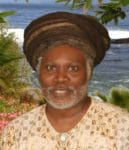
“In the first century of the Christian Era traveling by sea was attended with peculiar hardship and peril. Mariners directed their course largely by the position of the sun and stars; and when these did not appear, and there were indications of storm, the owners of vessels were fearful of venturing into the open sea.” (From Acts of the Apostles by Ellen G. White)
I was invited to join the SEA Colleague Voyage by Dr. Craig Marin, an associate professor of maritime studies. I accepted his offer. Part of the letter stated: “We are excited to have you join us in this engaging opportunity to learn more about our ocean-focused academic programs and the high-impact student experiences we offer.” The Sea Education Association, or SEA, is a non-profit educational institution that is recognized globally for its leadership in ocean education research.
This institution was established in 1971, emerging from a small seaside village on Cape Cod in Wood Hole, Massachusetts, the hub of oceanographic research and discovery. Believe me, I was excited to be chosen by such a great world class marine research vessel, the SSV Corwith Cramer, which is part of and operated by SEA. It was an opportunity of a lifetime to be with such distinguished researchers, professors, instructors, crews, and scientists, all of whom are experts within their own fields of discipline.
As I was driving down the road, listening to Radio AM 1000 early one morning before I ventured out to the open sea, the weather report came on announcing that the same week I would be sailing, the northern Virgin Islands waters would be impacted by powerful swells expected to bring high seas. With this news, I reflected on the story of Paul in the Bible. However, if you read Paul’s story, all persons on the ship were accounted for despite the challenges of mother nature’s fury on the sea.
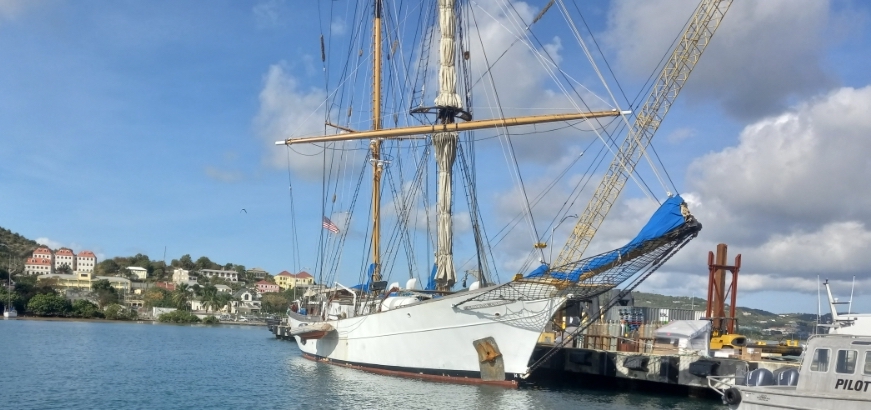
Somehow, I was assured by faith that everything would be alright. The vessel was docked at the Gallows Bay port. Everyone had a COVID-19 test as they boarded the ship. We all tested negative. To me, this meant that the voyage was on to explore the Virgin Islands’ marine environment. Before we departed, we gathered at the national park in Christiansted. Dr. Marin gave a brief history of the historical period of humans and modern marine exploration and how it relates to us today.
In addition, I spoke briefly about the prehistoric and colonial history of the Virgin Islands and the impacts it had on marine resources and how, culturally, Virgin Islanders are connected to the sea. For example, many of our historic buildings have coral embedded into their foundations. This tells me that we can’t separate the marine and terrestrial environments. That night, we anchored overnight off the northeast coast of Green Cay, one of our wildlife refuges in the Virgin Islands.
Stefan Edick, a great navigator of the sea and captain of the SSV Corwith Cramer, briefed us on safety aboard the ship. We also were briefed on what to expect for the next five days of sailing and the research activities that would be conducted. Before nightfall, we saw many sea turtles swimming near the ship, putting their heads above water to breathe. Believe me, it was a delightful sight to watch such a great display of these endangered reptiles. Just before sunrise, I smelled coffee in the air as I lay in my bunk. Meanwhile, the fresh Crucian breeze filled the morning air with coolness as some of us observed the sun rise from the east as we sailed toward the northern Virgin Islands.
The sea was calm that morning and the crew and we scientists on board were off for a great day to explore the marine world. On our way, we were visited by some more guests. This time, dolphins seemed to be having a great time whistling and clicking as they swam alongside the ship. Not long after, we were visited by a Blue-footed Booby flying over the ship. These birds are rare and endangered. Of course, the Magnificent Frigatebirds were present way up in the sky. The open Caribbean Sea’s fresh air greeted us as we took in the natural wonder of the West Indies.
On the ship, there were tasks for everyone to participate in. We were taught by the crew how to pull sail, stake the ship, read the compass, monitor computer readings, along with a long list of safety measures that provided us with a unique set of stewardship skills. As we approached St. Thomas, I thought of the mariners who traveled these waters thousands of years ago. We learned in history class that Christopher Columbus called these northern islands of the West Indies the Virgin Islands after St. Ursula and her 11,000 virgin companions.
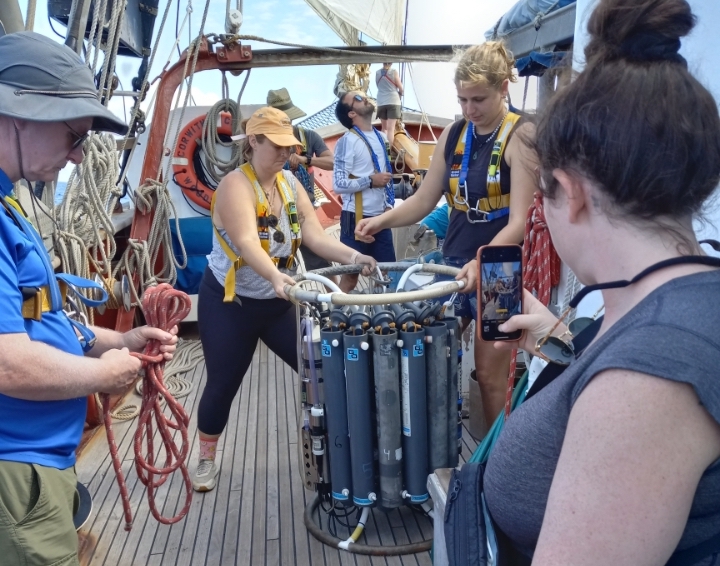
We anchored overnight off the coast of Buck Island National Wildlife Refuge south of the St. Thomas Harbor. Here, we focused on science curriculum and deployment and did several research projects. Marine equipment was lowered down onto the ocean floor to collect sediment. Samples were analyzed in the ship’s lab to increase our knowledge of the surrounding waters. We also collected planktons, which were analyzed in the lab. Planktons are microscopic organisms that play an important role in our marine ecosystems. These organisms provide about 70 to 80 percent of the oxygen that is critical to all living things on Earth.
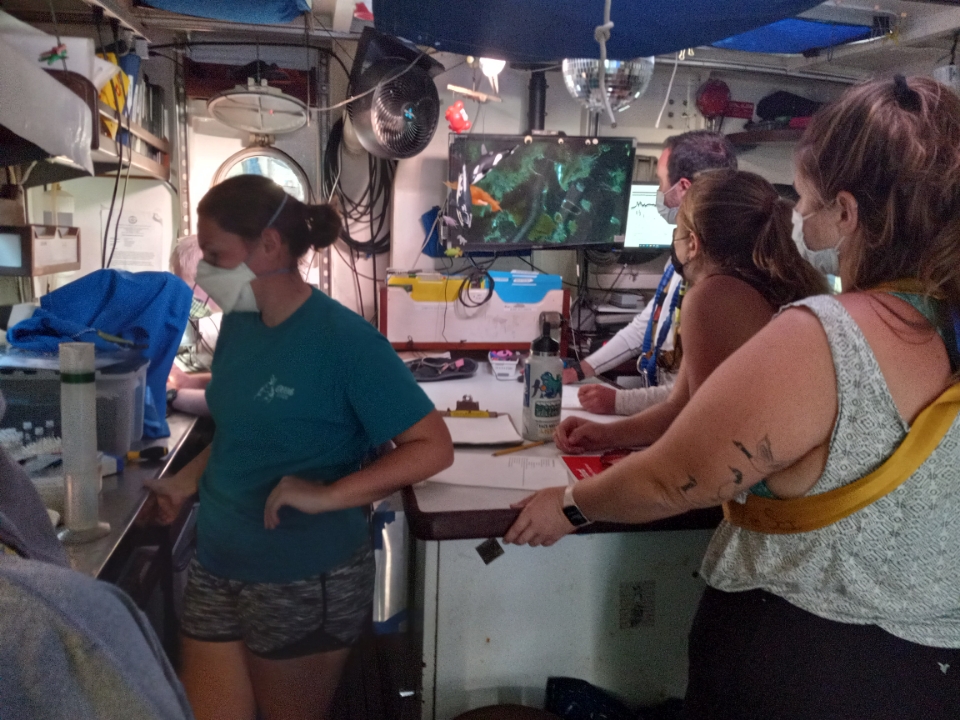
Acidification of our surrounding waters was analyzed as well. Ocean acidification in excess causes carbon dioxide to dissolve in the seawater, which poses a major threat to phytoplankton. You might not be aware, but microplastics — the billions of tiny bits of plastic manufactured by humans — deposited into the ocean also threaten plankton. We also analyzed bioluminescence, which is a type of plankton, a tiny marine organism that can sometimes cause the surface of the ocean to sparkle at night.
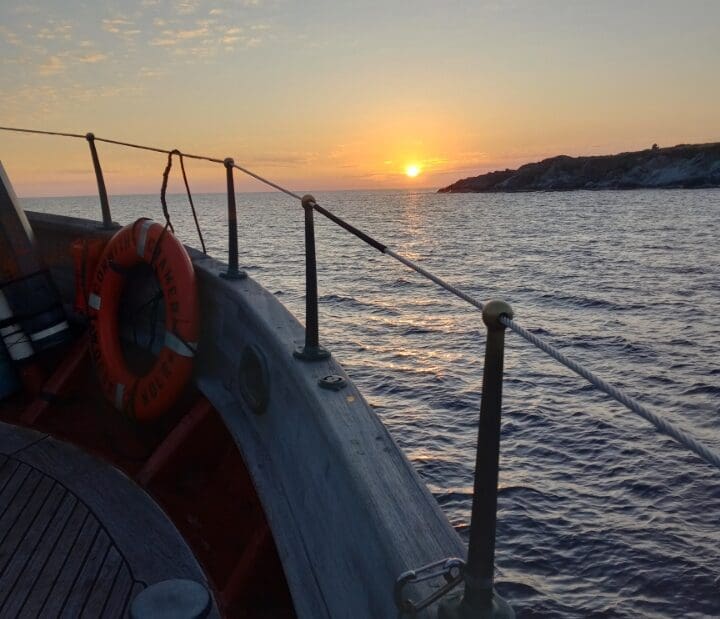
We then sailed to Francis Bay, in the Virgin Islands National Park on St. John. Here, we continued to focus on science, oceanography, and the coral reef environment. We visited some historic sites along the way and hiked to Leinster Bay where we snorkeled around Watermelon Cay to see how healthy the corals are. Dr. Heather Page, the chief scientist of SEA, taught us valuable skills to pass on to our students about the marine ecosystems. At night, we also learned about astronomy, which is important to sea navigation. And how can I forget? The food on the ship was great.
From my voyage adventure with SEA, the goal is to inspire ocean scholars, leaders, stewards of the Earth’s environment, and whatever career a student wants to pursue. I encourage high school students, teachers, professors, or anyone interested in learning more about SEA to contact them at www.sea.edu.
Believe me, it was a life-changing experience doing something positive for the Earth’s environment that is grounded in academics.
— Olasee Davis is a bush professor who lectures and writes about the culture, history, ecology and environment of the Virgin Islands when he is not leading hiking tours of the wild places and spaces of St. Croix and beyond.





